System Performance Analyses of Supercritical CO2 Brayton Cycle for Sodium-Cooled Fast Reactor
Abstract
:1. Introduction
2. Analysis Methods
2.1. Energetic Analysis
2.2. Exergetic Analysis
2.3. Exergoeconomic Analysis
2.4. Solution Procedures
3. Results and Discussions
3.1. Energy and Exergy Analyses with Different Layouts
3.2. System Performance of the Partial-Cooling Cycle
3.3. Effects of Operation Parameters on Cycle Efficiencies
3.3.1. Pressure Ratio
3.3.2. Inlet Temperature of the Main Compressor
3.3.3. Inlet Temperature of Turbine
3.4. Exergoeconomic Discussion
3.4.1. Pressure Ratio
3.4.2. Inlet Temperature of the Main Compressor
3.4.3. Inlet Temperature of Turbine
3.5. Comparison Summary of the Two Layouts
4. Conclusions
Author Contributions
Funding
Institutional Review Board Statement
Informed Consent Statement
Data Availability Statement
Acknowledgments
Conflicts of Interest
Nomenclature
| Symbols | |
| A | heat transfer area (m2) |
| β | compressor pressure ratio |
| c | cost rate per exergy unit (USD/GJ) |
| cost rate (USD/h) | |
| e | specific exergy (kJ/kg) |
| rate of exergy (MW) | |
| h | specific enthalpy (kJ/kg) |
| mass flow rate (kg/s) | |
| p | pressure (MPa) |
| rate of heat (MW) | |
| rate of work (MW) | |
| s | specific entropy (kJ/(kg·K)) |
| T | temperature (°C) |
| η | efficiency |
| capital cost rate (USD/h) | |
| Subscript | |
| a | setting of environment for analysis |
| cyc | cycle |
| comp | compressor |
| exe | exergy |
| MC | main compressor |
| Na-sCO2 | Na-sCO2 heat exchanger |
| partial | partial-cooling cycle |
| RC | recompressor |
| recomp | recompression cycle |
| recup | recuperators |
| RHT | recuperator HT |
| RLT | recuperator LT |
| Turb | turbine |
References
- Gianfranco, A. Method for Obtaining Mechanical Energy from a Thermal Gas Cycle with Liquid Phase Compression. U.S. Patent No. 3376706, 9 April 1968. [Google Scholar]
- Nami, H.; Mahmoudi, S.M.S.; Nemati, A. Exergy, ecomomic and environmental impact assessment and optimization of a novel cogeneration system including a gas turbine, a supercritical CO2 and an organic Rankine cycle (GT-HRSG/SCO2). Appl. Therm. Eng. 2017, 110, 1315–1330. [Google Scholar] [CrossRef]
- Chaudhary, A.; Mulchand, A.; Dave, P. Feasibility Study of Supercritical CO2 Rankine Cycle for Waste Heat Recovery, Proceedings. In Proceedings of the 6th International Symposium-Supercritical CO2 Power Cycles, Pittsburgh, PA, USA, 27–29 March 2018. [Google Scholar]
- Xie, M.; Xie, Y.H.; He, Y.C.; Dong, A.H.; Zhang, C.W.; Shi, Y.W.; Zhang, Q.H.; Yang, Q.G. Thermodynamic analysis and system design of the supercritical CO2 Brayton cycle for waste heat recovery of gas turbine. Heat Transf. Res. 2020, 51, 129–146. [Google Scholar] [CrossRef]
- Siddiqui, M.E. Thermodynamic Performance Improvement of Recopression Brayton Cycle Utilizing CO2-C7H8 Binary Mixture. Mechanika 2021, 27, 259–264. [Google Scholar] [CrossRef]
- Manzolini, G.; Binotti, M.; Bonalumi, D.; Invernizzi, C.; Iora, P. CO2 mixtures as innovative working fluid in power cycles applied to solar plants. Techno-economic assessment. Sol. Energy 2019, 181, 530–544. [Google Scholar] [CrossRef]
- Li, H.; Zhang, Y.; Yang, Y.; Han, W.; Yao, M.; Bai, W.; Zhang, L. Preliminary design assessment of supercritical CO2 cycle for commercial scale coal-fired power plants. Appl. Therm. Eng. 2019, 158, 113785. [Google Scholar] [CrossRef]
- Shi, Y.; Zhong, W.; Shao, Y.; Xiang, J. System Analysis on Supercritical CO2 Power Cycle with Circulating Fluidized Bed Oxy-Coal Combustion. J. Therm. Sci. 2019, 28, 505–518. [Google Scholar] [CrossRef]
- Siddiqui, M.E.; Almitani, K.H. Proposal and Thermodynamic Assessment of S-CO2 Brayton Cycle Layout for Improved Heat Recovery. Entropy 2020, 22, 305. [Google Scholar] [CrossRef] [Green Version]
- Haroon, M.; Sheikh, N.A.; Ayub, A.; Tariq, R.; Sher, F.; Beheta, A.T.; Imran, M. Exergetic, Economic and Exergo-Environmental Analysis of Bottoming Power Cycles Operating with CO2-Based Binary Mixture. Energies 2020, 13, 5080. [Google Scholar] [CrossRef]
- Garg, P.; Srinivasan, K.; Dutta, P.; Kumar, P. Comparison of CO2, and Steam in Transcritical Rankine Cycles for Concentrated Solar Power. Energy Procedia 2014, 49, 1138–1146. [Google Scholar] [CrossRef] [Green Version]
- Dunima, S.; Jahn, I.; Hooman, K.; Lu, Y.; Veeraragavan, A. Comparison of direct and indirect natural draft dry cooling tower cooling of the sCO2 Brayton cycle for concentrated solar power plants. Appl. Therm. Eng. 2018, 130, 1070–1080. [Google Scholar] [CrossRef]
- Handwerk, C.S.; Driscoll, M.J.; Hejzlar, P. Optimized Core Design of a Supercritical Carbon Dioxide-Cooled Fast Reactor. Nucl. Technol. 2007, 164, 3320–3336. [Google Scholar] [CrossRef]
- Pope, M.A. Thermal hydraulic design of a 2400 MWth Direct Supercritical Co-Cooled Fast Reactor. Ph.D. Thesis, Institute of Technology, Cambridge, MA, USA, 2006. [Google Scholar]
- Gao, W.; Yao, M.Y.; Chen, Y.; Li, H.; Zhang, Y.; Zhang, L. Performance of S-CO2 Brayton Cycle and Organic Rankine Cycle (ORC) Combined System Considering the Diurnal Distribution of Solar Radiation. J. Therm. Sci. 2019, 28, 463–471. [Google Scholar] [CrossRef]
- Nuclear Development Report, Risks and Benefits of Nuclear Energy; NEA No. 6242; OECD Nuclear Energy Agency: Paris, France, 2007.
- Sienicki, J.J.; Moisseytsev, A. Nuclear Power. In Fundamentals and Applications of Supercritical Carbon Dioxide (sCO2) Based Power Cycles; Brun, K., Friedman, P., Dennis, R., Eds.; Woodhead Publishing: Sawston, UK, 2017; pp. 339–391. [Google Scholar]
- Hoffmann, J.R.; Feher, E.G. 150 kWe Supercritical Closed Cycle System. ASME J. Eng. Power. 1971, 93, 70–80. [Google Scholar] [CrossRef]
- Feher, E.G.; Harvey, R.A.; Milligan, H.H. 150-kWe Supercritical Cycle Turbo-pump Design Layout and Performance Demonstration Final Technical Report; McDonnell Douglas Astronautics Company-West: St. Louis, MO, USA, 1971. [Google Scholar]
- Dievoet, V.J.P. The sodium-CO2 fast breeder reactor concept. In Proceedings of the International Conference on Sodium Technology and Large Fast Reactor Design, Bologna, Italy, 7–9 November 1968. [Google Scholar]
- Sienicki, J.J.; Moisseytsev, A.; Krajtl, L. A Supercritical CO2 Brayton Cycle Power Converter for a Sodium-Cooled Fast Reactor Small Modular Reactor. In Proceedings of the ASME 2015 Nuclear Forum collocated with the ASME 2015 Power Conference, the ASME 2015 9th International Conference on Energy Sustainability, and the ASME 2015 13th International Conference on Fuel Cell Science, Engineering and Technology. American Society of Mechanical Engineers, San Diego, CA, USA, 28 June–2 July 2015. V001T01A004. [Google Scholar]
- Grandy, C.; Sienicki, J.J.; Moisseytsev, A.; Krajtl, L.; Farmer, M.T.; Kim, T.K.; Middleton, B. Advanced Fast Reactor—100 (AFR-100) Report for the Technical Review Panel; U.S. Department of Commerce National Technical Information Service: Alexandra, VA, USA, 2014. [Google Scholar]
- Masakazu, I.; Tomoyasu, M.; Shoji, K. A Next Generation Sodium-cooled Fast Reactor Concept and Its R&D Program. Nucl. Eng. Technol. 2007, 3, 171–186. [Google Scholar]
- Moisseytsev, A.; Sienicki, J.J. Investigation of alternative layouts for the supercritical carbon dioxide Brayton cycle for a sodium-cooled fast reactor. Nucl. Eng. Des. 2009, 239, 1362–1371. [Google Scholar] [CrossRef]
- Xie, M.; Xie, Y.H.; Zhang, Q.H.; He, Y.; Dong, A.; Zhang, C.; Shi, Y.; Yang, Q. Thermodynamic Analysis and Multiple System Layouts Comparison of the Supercritical CO2 Brayton Cycle for Sodium-cooled Fast Reactor with Offshore Scenes. In Proceedings of the International Conference on Energy, Ecology and Environment (ICEEE 2018) and International Conference on Electric and Intelligent Vehicles (ICEIV 2018), Melbourne, Australia, 21–25 November 2018. [Google Scholar]
- Neises, T.; Turchi, C. Supercritical CO2 Power Cycles: Design Considerations for Concentrating Solar Power. In Proceedings of the The 4th International Symposium-Supercritical CO2 Power Cycles, Pittsburgh, PA, USA, 9–10 September 2014. [Google Scholar]
- Lu, S.P.; Liu, Y.W.; Lin, Y.S. Parameters optimization of supercritical carbon dioxide Brayton cycle based on CEFR. Energy Conserv. 2018, 7, 21–26. [Google Scholar]
- Siddiqui, M.E.; Almitani, K.H. Energy and Exergy Assessment of S-CO2 Brayton Cycle Coupled with a Solar Tower System. Processes 2020, 8, 1264. [Google Scholar] [CrossRef]
- Noaman, M.; Saade, G.; Morosuk, T.; Tsataronis, G. Exergoeconomic Analysis Applied to Supercrtical CO2 Power Systems. Energy 2019, 183, 756–765. [Google Scholar] [CrossRef]
- Xie, M.; Xie, Y.; Zhang, Q.; Zhang, C.; Dong, A.; Shi, Y.; Zhang, Y. Exergy and Exergoeconomic Analyses Based on Recompression Cycle of the Supercritical CO2 Brayton Cycle for Sodium-cooled Fast Reactor. In Proceedings of the International Conference on Energy, Ecology and Environment (ICEEE 2019) and International Conference on Electric and Intelligent Vehicles (ICEIV 2019), Stavanger, Norway, 23–27 July 2019. [Google Scholar]
- Shokati, N.; Mohammadkhani, F.; Yari, M.; Mahmoudi, S.M.S.; Rosen, M.A. A comparative exergoeconomic analysis of waste heat recovery from a gas turbine-modular helium reactor via organic Rankine cycles. Sustainability 2013, 6, 2474–2489. [Google Scholar] [CrossRef] [Green Version]
- Mohammadkhani, F.; Shokati, N.; Mahmoudi, S.M.S.; Yari, M.; Rosen, M.A. Exergoeconomic assessment and parametric study of a gas turbine-modular helium reactor combined with two organic rankine cycles. Energy 2014, 65, 533–543. [Google Scholar] [CrossRef]
- Khaljani, M.; Saray, R.K.; Bahlouli, K. Comprehensive analysis of energy, exergy and exergo-economic of cogeneration of heat and power in a combined gas turbine and organic rankine cycle. Energy Convers. Manag. 2015, 97, 154–165. [Google Scholar] [CrossRef]
- Schultz, K.R.; Brown, L.C.; Besenbruch, G.E.; Hamilton, C.J. Large Scale Production of Hydrogen by Nuclear Energy for the Hydrogen Economy; GA-A24265; General Atomics: San Diego, CA, USA, 2003. [Google Scholar]
- Ghaebi, H.; Amidpour, M.; Karimkashi, S.; Rezayan, O. Energy, exergy and thermoeconomic analysis of a combined cooling, heating and power (CCHP) system with gas turbine prime mover. Int. J. Energy Res. 2011, 35, 697–709. [Google Scholar] [CrossRef]
- Guo, Y.Z.; En, W.; Shan, T.T. Techno-economic study on compact heat exchangers. Int. J. Energy Res. 2008, 32, 1119–1127. [Google Scholar]
- Dixon, B.; Ganda, F.; Hoffman, E.A.; Hansen, J. Advanced Fuel Cycle Cost Basis—2017 Edition; U.S. Department of Energy Fuel Cycle Options Campaign: Washington, DC, USA, 2017. [Google Scholar]
- Wang, X.; Yang, Y.; Zheng, Y.; Dai, Y. Exergy and exergoeconomic analyses of a supercritical CO2 cycle for a cogeneration application. Energy 2017, 119, 971–982. [Google Scholar] [CrossRef]
- Zare, V.; Mahmoudi, S.M.S.; Yari, M. An exergoeconomic investigation of waste heat recovery from the Gas Turbine-Modular Helium Reactor (GT-MHR) employing an ammonia–water power/cooling cycle. Energy 2013, 61, 397–409. [Google Scholar] [CrossRef]

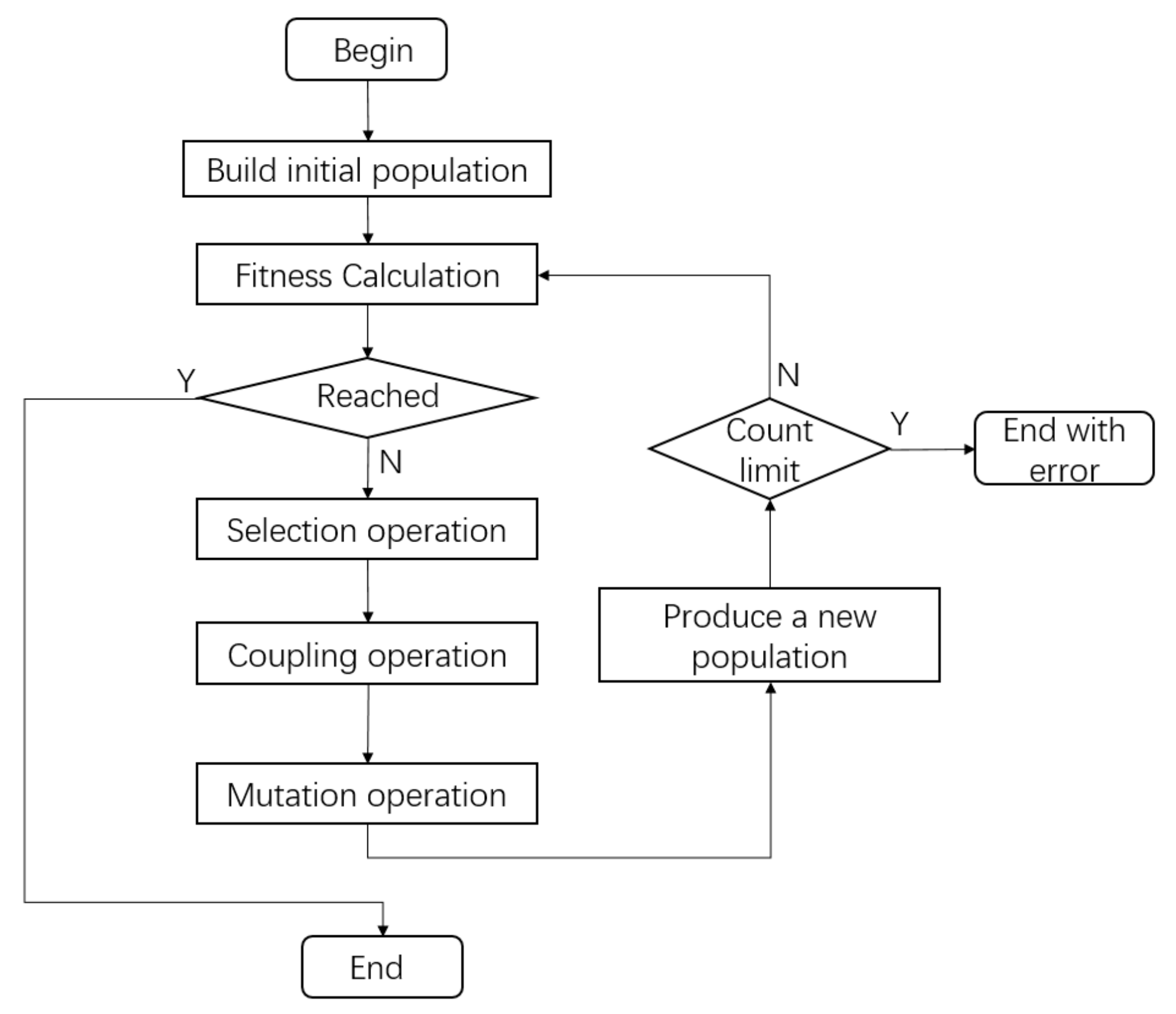




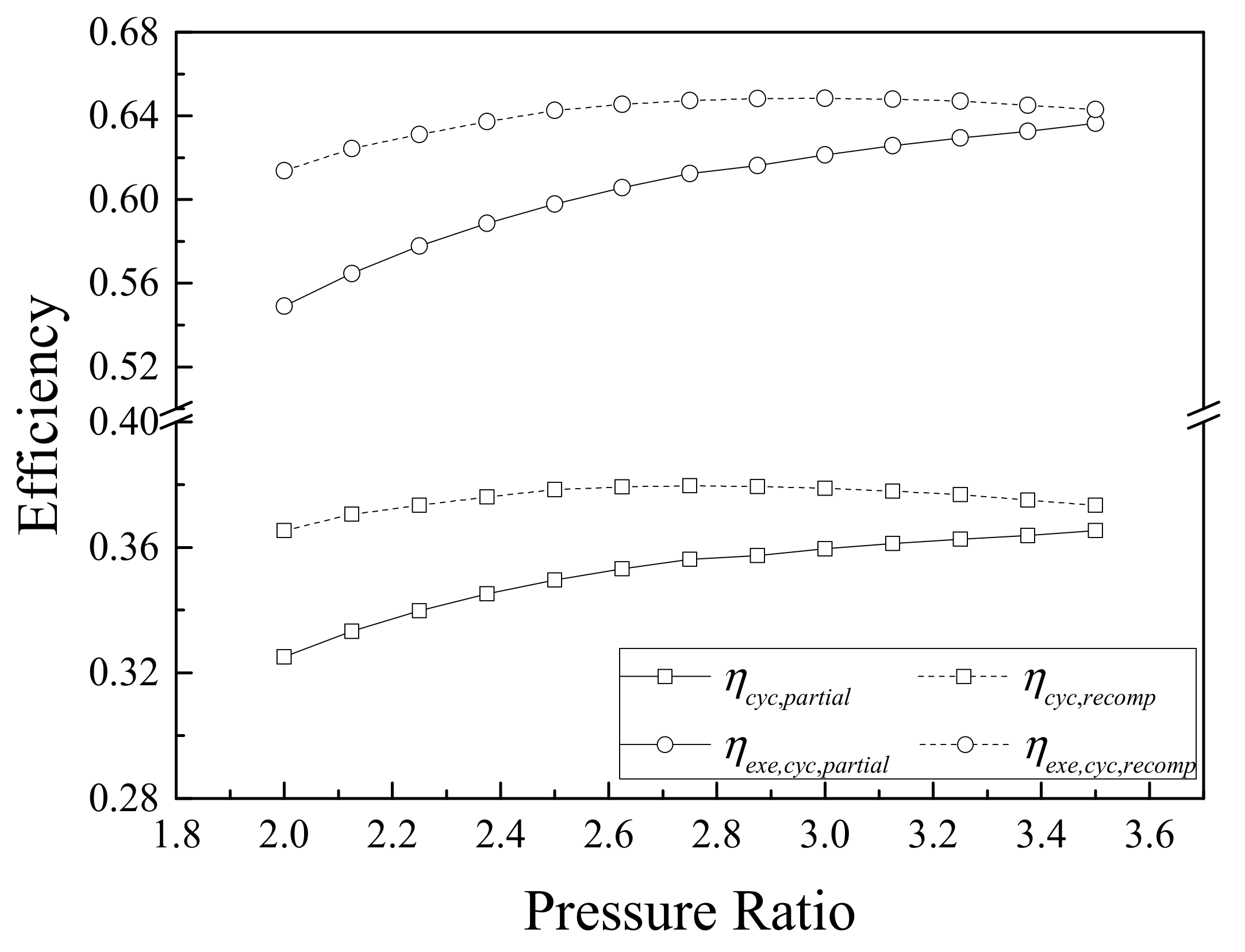

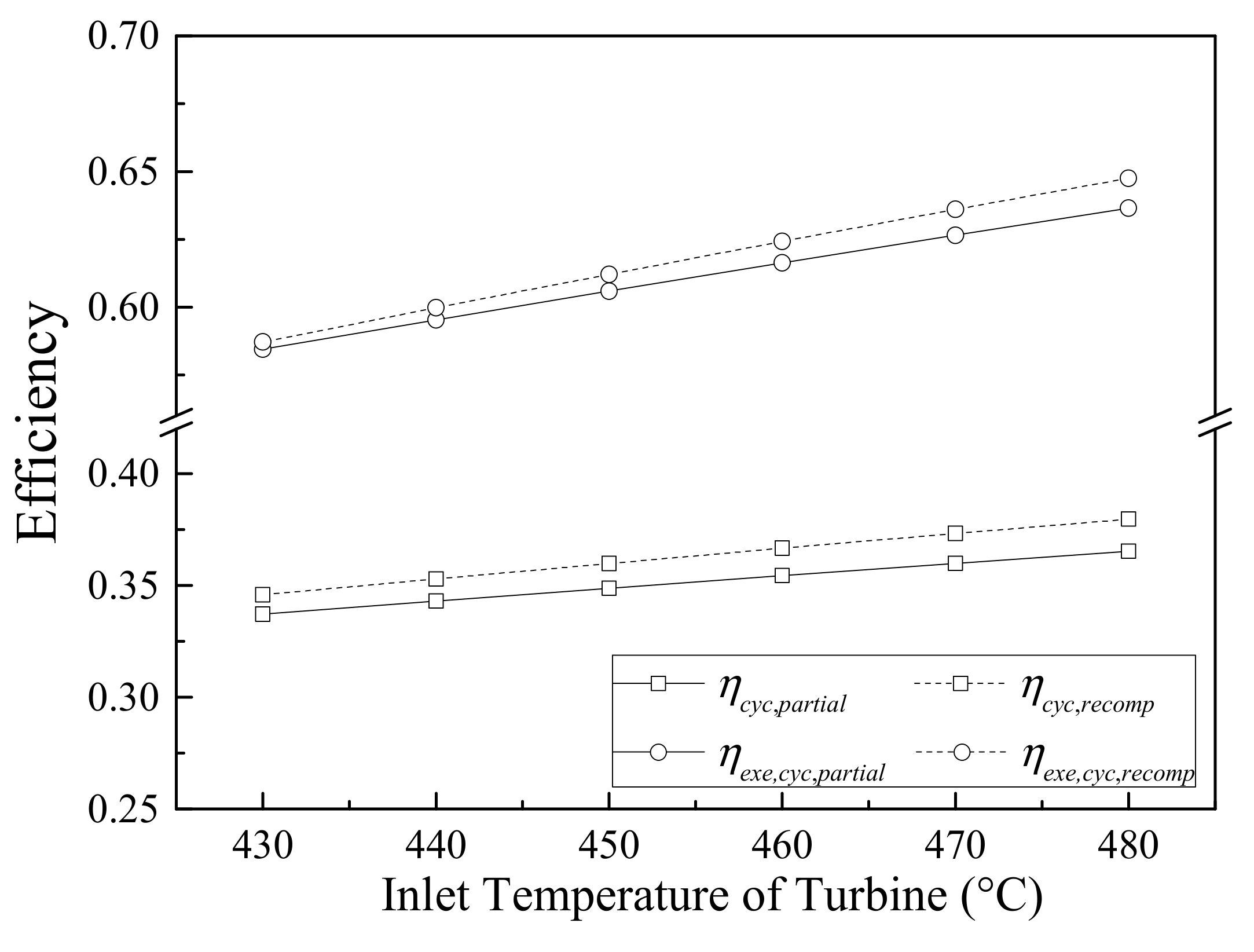

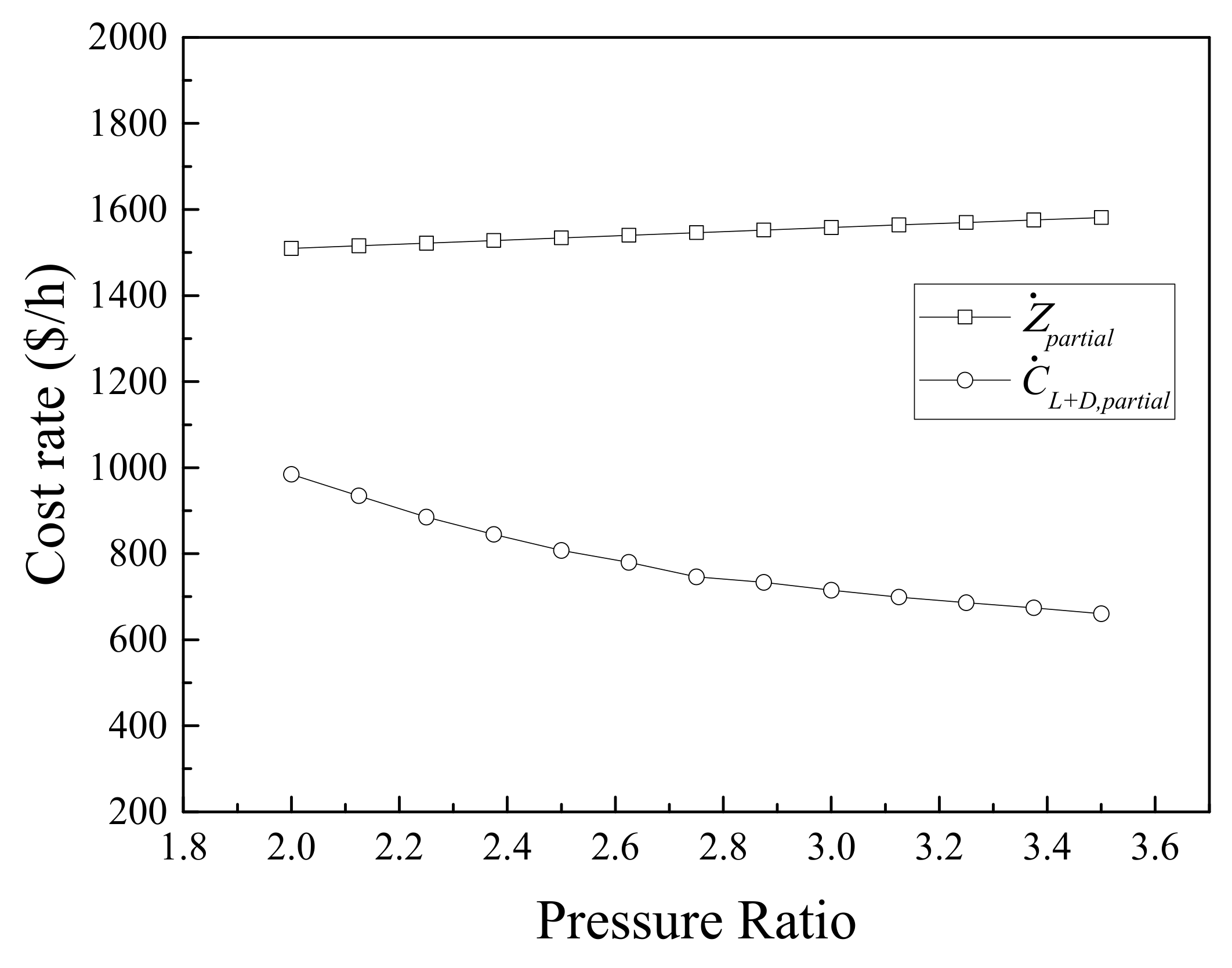



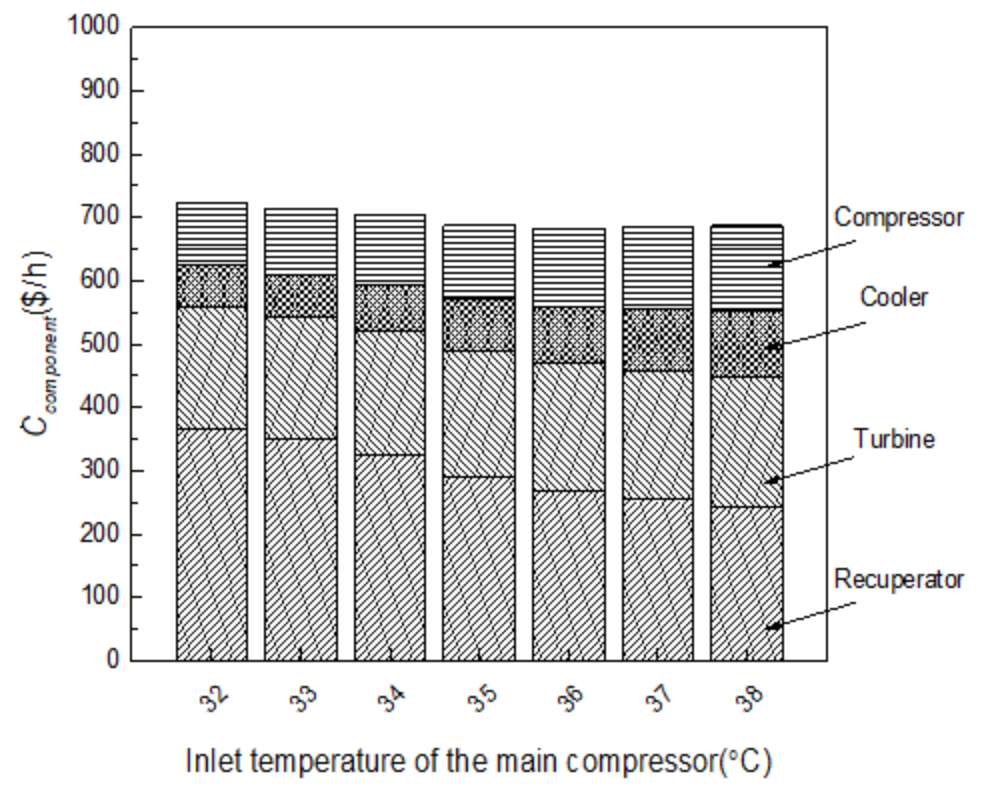

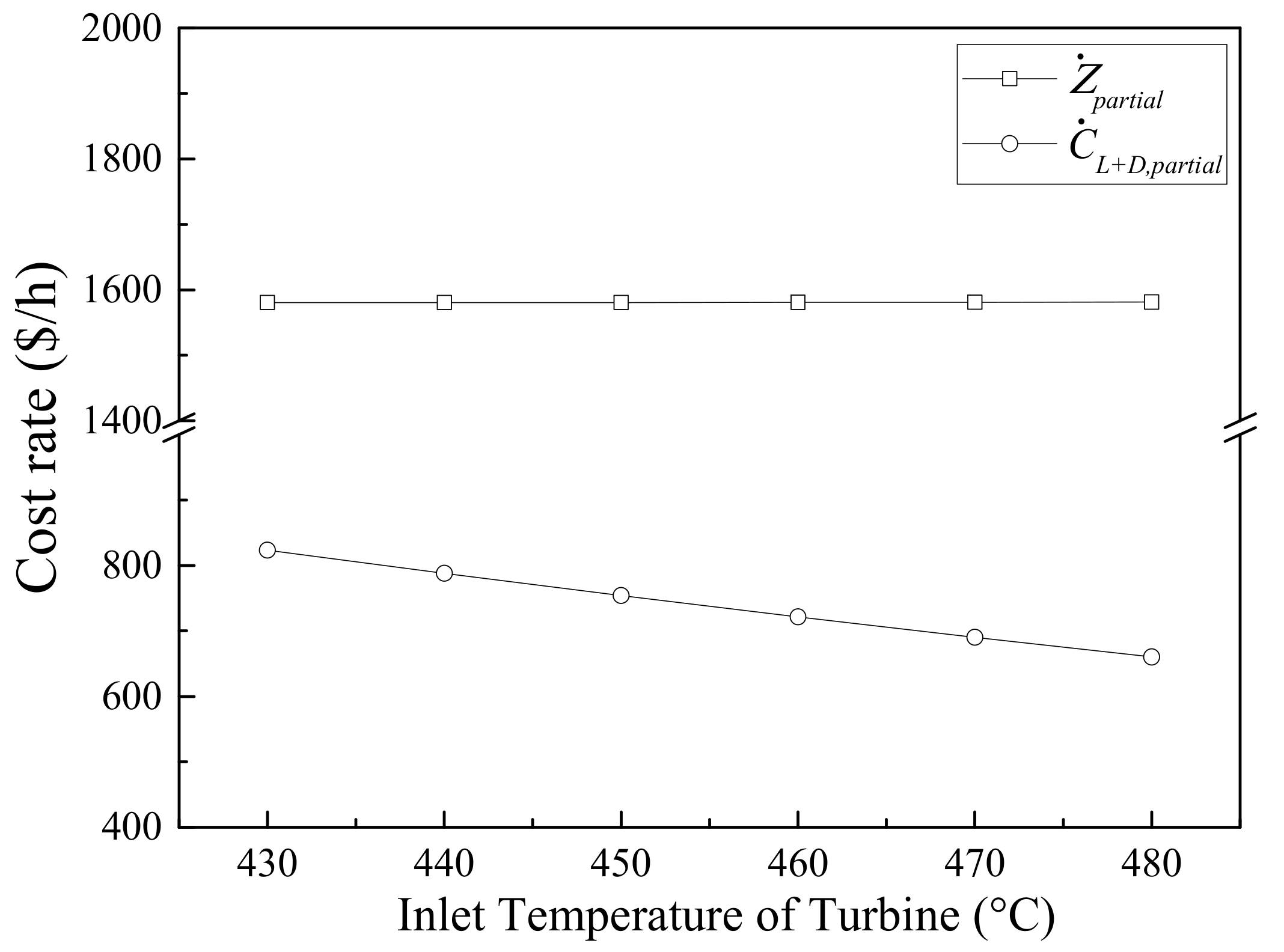

| Component | Cited Data for Cost of Components |
|---|---|
| Reactor core [34] | |
| Turbine [35] | |
| Compressors [35] | |
| Recuperators [36] | |
| Coolers [36] | |
| Reactor core [33,37,38,39] | = 7.4 USD/(MW·h) |
| Component | Fuel | Product |
|---|---|---|
| Reactor core (including Na-sCO2 Heat Exchanger) | ||
| Turbine | ||
| Recuperator HT | ||
| Recuperator LT | ||
| Main Cooler | ||
| Subcooler | ||
| Main Compressor | ||
| Recompressor LT | ||
| Recompressor HT |
| Component | Balance Equation | Auxiliary Equation(s) |
|---|---|---|
| Reactor core (including Na-sCO2 Heat Exchanger) | - | |
| Turbine | ||
| Recuperator HT | ||
| Recuperator LT | ||
| Main Cooler | ||
| Subcooler | ||
| Main Compressor | ||
| Recompressor LT | ||
| Recompressor HT |
| Parameter | Symbol | Range | Step Size |
|---|---|---|---|
| Maximum pressure of the cycle | MPa | 0.50 MPa | |
| Minimum pressure of the cycle | MPa | 0.50 MPa | |
| Mass flow rate of the sCO2 | kg/s | 1.00 kg/s | |
| Maximum temperature of the cycle | °C | 1.00 °C | |
| Minimum temperature of the cycle | °C | 1.00 °C | |
| Split ratios | r | [0.1, 0.9] | 0.05 |
| Items | Partial Cooling | Recompression | ||
|---|---|---|---|---|
| Power (MW) | Ratio (%) | Power (MW) | Ratio (%) | |
| 3.57 | 6.61 | 2.06 | 4.23 | |
| 5.82 | 10.77 | 5.02 | 10.28 | |
| 4.38 | 8.10 | 3.17 | 6.49 | |
| 3.60 | 6.67 | 3.48 | 7.13 | |
| 2.27 | 4.21 | 2.37 | 4.85 | |
Publisher’s Note: MDPI stays neutral with regard to jurisdictional claims in published maps and institutional affiliations. |
© 2022 by the authors. Licensee MDPI, Basel, Switzerland. This article is an open access article distributed under the terms and conditions of the Creative Commons Attribution (CC BY) license (https://creativecommons.org/licenses/by/4.0/).
Share and Cite
Xie, M.; Cheng, J.; Ren, X.; Wang, S.; Che, P.; Zhang, C. System Performance Analyses of Supercritical CO2 Brayton Cycle for Sodium-Cooled Fast Reactor. Energies 2022, 15, 3555. https://doi.org/10.3390/en15103555
Xie M, Cheng J, Ren X, Wang S, Che P, Zhang C. System Performance Analyses of Supercritical CO2 Brayton Cycle for Sodium-Cooled Fast Reactor. Energies. 2022; 15(10):3555. https://doi.org/10.3390/en15103555
Chicago/Turabian StyleXie, Min, Jian Cheng, Xiaohan Ren, Shuo Wang, Pengcheng Che, and Chunwei Zhang. 2022. "System Performance Analyses of Supercritical CO2 Brayton Cycle for Sodium-Cooled Fast Reactor" Energies 15, no. 10: 3555. https://doi.org/10.3390/en15103555






